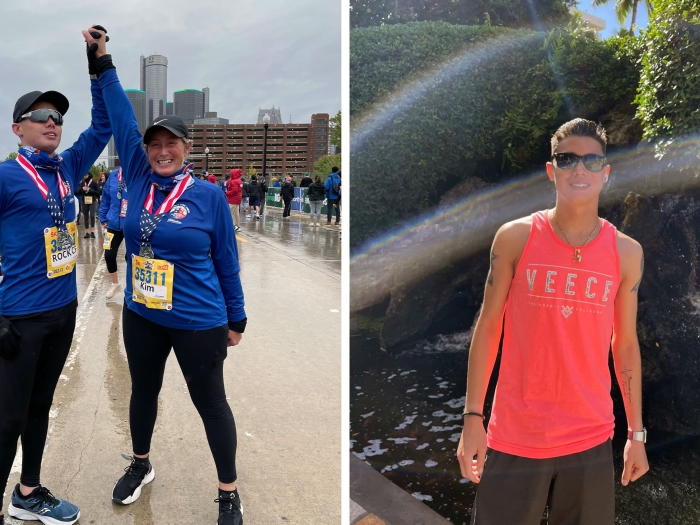After her lung volume reduction surgery, emphysema patient Tami Kelley is breathing easier. Her doctors explain what the procedure entails and who is eligible.
7:00 AM
Author |

Kelley, pictured at right: "100 percent happy" after having surgery.
Tami Kelley still recalls the night five years ago when her life changed.
A certified nurse assistant, she developed a bad cough and severe migraine that kept her from working a typical midnight shift at her nursing home job.
LISTEN UP: Add the new Michigan Medicine News Break to your Alexa-enabled device, or subscribe to our daily audio updates on iTunes, Google Play and Stitcher.
Kelley took migraine medication, used an inhaler for her asthma and went to bed, hoping to wake up pain-free.
But during the night, the Herron, Michigan, resident woke up with an unrelenting headache that convinced her she needed medical attention.
Her husband, Tim, drove her to the emergency room of a nearby hospital, unaware of his wife's life-threatening health issue.
An unexpected diagnosis
Kelley's condition quickly deteriorated upon arrival. Unable to breathe, the 32-year-old spent the next four days in intensive care, unconscious and on a ventilator.
Eventually, as her condition improved, she was able to breathe on her own with the help of oxygen, inhalers and steroids — but her lung function was dangerously low.
A chest X-ray revealed that Kelley's lungs were severely damaged due to emphysema.
MORE FROM MICHIGAN: Sign up for our weekly newsletter
Emphysema is a chronic disease in which tiny air sacs at the end of the airways in the lungs become damaged, causing the air sac walls to break down and expand. The larger air sacs move less oxygen into the blood, which makes it hard to breathe.
Emphysema typically gets worse over time. Cigarette smoking, air pollution and lung infections, among other things, can cause it.
Although Kelley was a smoker, her mother also informed the doctors that her daughter was born prematurely and had been in an incubator as a newborn. Kelley also had developed pneumonia at age 13.
Both factors, combined with smoking, might have contributed to her lung condition, doctors said.
A change in treatment
The mother of two was transferred to the University of Michigan, where the pulmonary team confirmed her emphysema diagnosis and recommended a possible single or double lung transplant.
SEE ALSO: Who Should Be Screened for Lung Cancer?
Because Kelley faced a significant wait for a suitable match, Michigan Medicine pulmonologist Kevin Chan, M.D., suggested she might be a candidate for lung volume reduction surgery, or LVRS.
The surgery involves removing the damaged areas of the lung, allowing the remaining lung tissue to expand when a patient breathes in. This surgery is recommended for people with severe emphysema or certain types of chronic obstructive pulmonary disease (COPD).
According to Chan, the procedure was studied extensively in a National Institutes of Health trial and showed significant improvement in quality of life and exercise capacity — as well as increased life span in a certain subset of patients. U-M was one of 17 health systems participating in the trial.
Eligibility for lung volume reduction surgery
During LVRS, 20 to 35 percent of the most damaged regions of each lung is removed, enabling the remaining lung to function better and easing symptoms associated with advanced emphysema.
Still, it isn't right for everyone.
About 10 percent of patients with emphysema are considered candidates for the surgery, says Michigan Medicine surgeon Philip Carrott, M.D.
"The best candidates for LVRS are patients who have significantly more damage to the upper lobes than the lower ones and who have low exercise tolerance," Carrott says.
In those cases, "the benefits greatly outweigh the risks when compared to those associated with lung transplantation," Chan says. "All patients with emphysema and COPD are evaluated for LVRS when seen as a lung transplant referral at Michigan Medicine."
Going the distance
After consulting with her husband and two sons, Kelley agreed to LVRS, which was performed by Carrott in October 2016. The surgery required six incisions to access and remove the damaged areas of her lungs.
"I felt better just hours after the surgery," Kelley recalls.
SEE ALSO: Life with Pulmonary Fibrosis: 'I'm On a Good Path'
Although she still has emphysema, Kelley is now symptom-free. She can do housework without stopping to rest and happily reports that she can get through her day without a nap.
"Kelley was a good candidate for LVRS," Carrott says. "She was able to get off oxygen and is doing great. We're hopeful that her lung disease has stabilized and that this will be a long-term outcome for her. Not all patients are so fortunate."
Since the surgery, Kelley goes to pulmonary therapy twice a week to continue to build her lung capacity.
"We're 100 percent happy that we decided to have this surgery," Kelley says. "My family was very nervous about the outcome but wanted so much for me to be able to do more and to have a better quality of life."
Proof of her newfound staying power? "My husband says he knows I'm better because our shopping bills have gotten higher," she says with a smile.

Explore a variety of health care news & stories by visiting the Health Lab home page for more articles.

Department of Communication at Michigan Medicine
Want top health & research news weekly? Sign up for Health Lab’s newsletters today!





